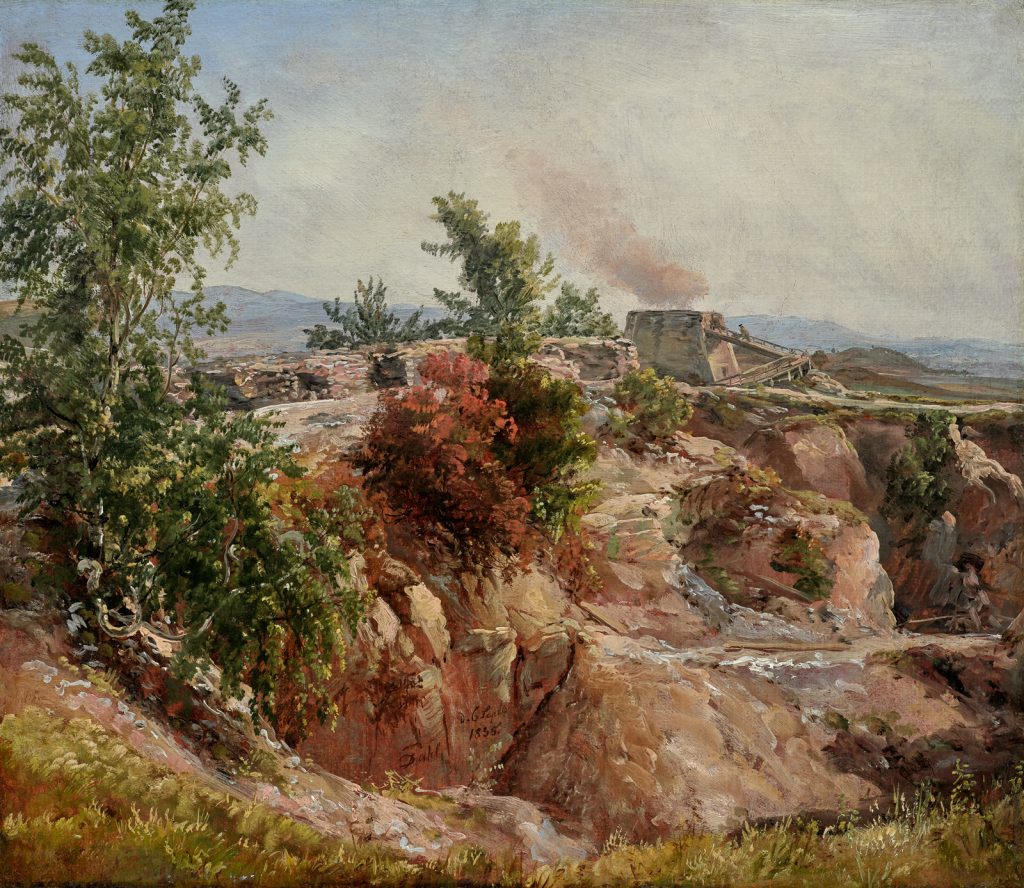Johan Christian Dahl
(Bergen, Norway 1788 - 1857 Dresden)
A Chalk Pit near Maxen, Dresden, 1835
Oil on paper, laid down on canvas, 32.5 x 37.5 cm
Signed and dated lower center JDahl / d. 6. Sept. / 1835.
Provenance:
Justitiarius Georg J. Bull, grandson of Peder Balke;
General Siegwald Bull, grandson of Peder Balke;
Eric Bull, Oslo, acquired by 1937, until at least 1957;
Thence by descent in the Bull family;
Asbjørn Lunde (1927-2017), New York, from 2006, inv. 516.
Exhibited:
Katalog over Professor Dahl udstilligen, Christiania Kunstforening, 1907, no. 31;
Norges Kunst Jubilæumsutstillingen 1814-1914, Oslo, Frognerparken, 1914, no. 76;
Mindeutstilling, J.C. Dahl 1788-1857, Oslo, Blomqvist Kunsthandel, 1926, no. 148;
J.C. Dahl's verk, Minneutstilling, Oslo, Kunstnernes Hus, 1937, no. 429;
Malerier og Tegninger av J. C. Dahl, Oslo, Nasjonalgalleriet and Bergen Billedgalleri, 1957, no. 120;
Johan Christian Dahl 1788-1857: Jubileumsutstilling 1988, Oslo, Nasjonalgalleriet and Bergen Billedgalleri, 1988, no. 148;
Den ville natur. Sveitisk og norsk romantikk. Malerier fra Asbjorn Lundes samling, New York, Tromsø, Nordnorsk Kunstmuseum and Bergen Billedgalleri, 2007, p. 104, no. 28;
Forests, Rocks, Torrents: Norwegian and Swiss Landscapes from the Lunde Collection, London, National Gallery, 2011, no. 16;
Sublime North: Romantic Painters Discover Norway. Paintings from the Collection of Asbjørn Lunde, Hartford, Wadsworth Atheneum Museum of Art, September 2017-January 2018.
Literature:
Andreas Aubert, Maleren Johan Christian Dahl: et stykke av forrige aarhundredes kunst- og kulturhistorie, Oslo 1920, p. 453;
Johan H. Langaard, J.C. Dahl’s verk, Oslo 1937, p. 101, no. 429;
Marie Lødrup Bang, Johan Christian Dahl, 1788-1857. Life and Works, catalogue raisonné, II, Oslo 1987, no. 790; III, plate CCCXXXIV, no. 790.
The small municipality of Maxen is situated on a high plateau between Lockwitztal and Müglitztal. In Dahl’s time, the delightful hilly countryside south-east of Dresden was a popular destination for hikers attracted by its panoramic views of the Sächsische Schweiz and the Erzgebirge. Many of the visitors to the area came as guests of Friederike (1800-72) and Friedrich Anton Serre (1789-1863), a cultivated, art-loving couple who had bought a country estate in Maxen in 1819. They played host to a multitude of distinguished figures – among them Ludwig Tieck, Hans Christian Andersen, Ottilie von Goethe, and Clara and Robert Schumann. In 1841, Serre set up a foundation, the Tiedge-Stiftung, to support impoverished artists. He was also a founding member of the Schillerstiftung in 1859.1
Dahl was also in Maxen and visited the Serres at their country seat. Marie Lødrup Bang notes that ‘Frau Majorin von Serre’ owned eight of his works, most of them personal gifts from Dahl himself. Friederike Serre also owned a painting of 1841 by Dahl titled Landscape between Pirna and Maxen (Bang 942). Bertel Thorvaldsen is believed to have purchased it from Dahl and offered it to her as a gift. Dahl visited Maxen in early September 1835 – the present oil study is dated 6. Sept. 1835. He took advantage of his stay to discover a somewhat unconventional motif, the limestone quarry and limekiln near the village. In the late sixteenth century an important discovery had been made near Maxen. A type of limestone was discovered from which bunter Marmor [polychrome marble] could be obtained. Types of limestone suitable for the production of quicklime were also found at the same spot.
Dahl’s primary focus of interest is the spectrum of colors perceived on the rock formations in the quarry. The soft pinkish tone of the rock is accentuated with touches of green and brown where patches of vegetation grow. At the left of the image is a tall birch, a recurrent motif in Dahl’s paintings: ‘The role of the birch in Dahl’s work can be compared with that of the oak in Friedrich’s paintings.’2 A plume of smoke rises from the chimney of the limekiln in the background. The tiny figure of a workman can be seen pushing a wheelbarrow laden with limestone up a ramp to replenish the kiln.
Serre was a successful entrepreneur. He enlarged the existing quarries and modernized the limekilns. His social commitment was exemplary. He set up a benefit fund for his employees.
1 See Lothar Bolze, Serres und ihre Freunde, Dresden 2000, and <https://www.sachsen-erkunden.de/bergdorf-maxen-mueglitztal/> (accessed January 24, 2019).
2 Dahl und Friedrich. Romantische Landschaften, exhib. cat., Staatliche Kunstsammlungen Dresden and Oslo, Najsonalmuseet for kunst, architektur og design, Oslo and Dresden 2014, p. 111.

